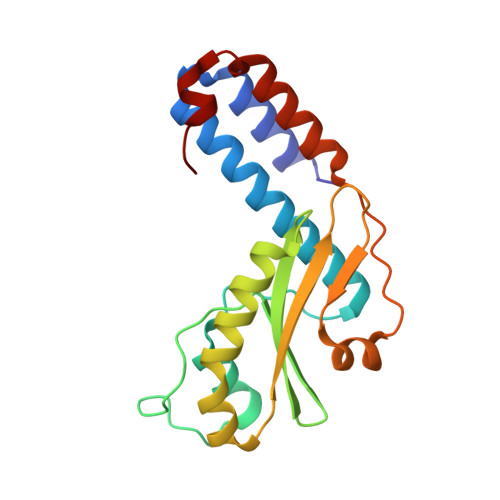Bunyaviridae RNA Polymerases (L-Protein) Have an N-Terminal, Influenza-Like Endonuclease Domain, Essential for Viral CAP-Dependent Transcription.
Reguera, J., Weber, F., Cusack, S.(2010) PLoS Pathog 6: 1101
- PubMed: 20862319
- DOI: https://doi.org/10.1371/journal.ppat.1001101
- Primary Citation of Related Structures:
2XI5, 2XI7 - PubMed Abstract:
Bunyaviruses are a large family of segmented RNA viruses which, like influenza virus, use a cap-snatching mechanism for transcription whereby short capped primers derived by endonucleolytic cleavage of host mRNAs are used by the viral RNA-dependent RNA polymerase (L-protein) to transcribe viral mRNAs. It was recently shown that the cap-snatching endonuclease of influenza virus resides in a discrete N-terminal domain of the PA polymerase subunit. Here we structurally and functionally characterize a similar endonuclease in La Crosse orthobunyavirus (LACV) L-protein. We expressed N-terminal fragments of the LACV L-protein and found that residues 1-180 have metal binding and divalent cation dependent nuclease activity analogous to that of influenza virus endonuclease. The 2.2 A resolution X-ray crystal structure of the domain confirms that LACV and influenza endonucleases have similar overall folds and identical two metal binding active sites. The in vitro activity of the LACV endonuclease could be abolished by point mutations in the active site or by binding 2,4-dioxo-4-phenylbutanoic acid (DPBA), a known influenza virus endonuclease inhibitor. A crystal structure with bound DPBA shows the inhibitor chelating two active site manganese ions. The essential role of this endonuclease in cap-dependent transcription was demonstrated by the loss of transcriptional activity in a RNP reconstitution system in cells upon making the same point mutations in the context of the full-length LACV L-protein. Using structure based sequence alignments we show that a similar endonuclease almost certainly exists at the N-terminus of L-proteins or PA polymerase subunits of essentially all known negative strand and cap-snatching segmented RNA viruses including arenaviruses (2 segments), bunyaviruses (3 segments), tenuiviruses (4-6 segments), and orthomyxoviruses (6-8 segments). This correspondence, together with the well-known mapping of the conserved polymerase motifs to the central regions of the L-protein and influenza PB1 subunit, suggests that L-proteins might be architecturally, and functionally equivalent to a concatemer of the three orthomyxovirus polymerase subunits in the order PA-PB1-PB2. Furthermore, our structure of a known influenza endonuclease inhibitor bound to LACV endonuclease suggests that compounds targeting a potentially broad spectrum of segmented RNA viruses, several of which are serious or emerging human, animal and plant pathogens, could be developed using structure-based optimisation.
Organizational Affiliation:
European Molecular Biology Laboratory, Grenoble Outstation, Grenoble, France.















